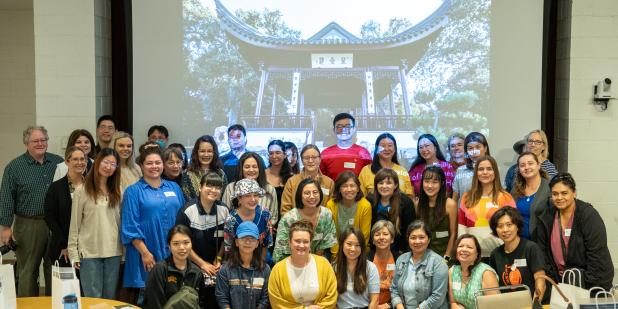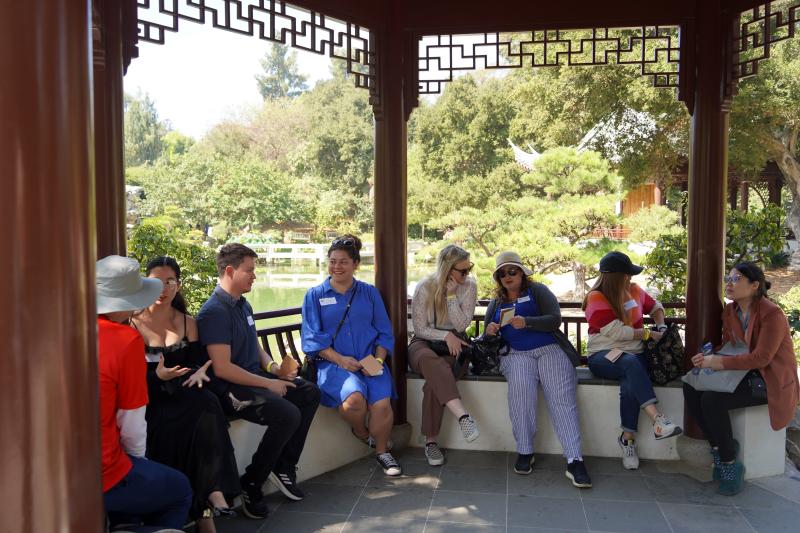Join us for a free one-day workshop for educators at the Japanese American National Museum, hosted by the USC U.S.-China Institute and the National Consortium for Teaching about Asia. This workshop will include a guided tour of the beloved exhibition Common Ground: The Heart of Community, slated to close permanently in January 2025. Following the tour, learn strategies for engaging students in the primary source artifacts, images, and documents found in JANM’s vast collection and discover classroom-ready resources to support teaching and learning about the Japanese American experience.
The Chinese Garden as a Teaching Tool, a USCI Workshop for Educators

The USC U.S.-China Institute program for teachers returned to the Huntington on Saturday, September 29, 2024. 38 teachers from across Southern California joined the workshop which featured presentations by Kristin Brisbois, Huntington head of learning programs, and Philip Bloom, curator of the Chinese garden. The Huntington has been a partner of our program for two decades. This visit focused on the history and features of the garden and how K-12 educators might use it as a teaching tool. The Huntington is among the most popular destinations in California. The Chinese garden welcomes about 800,000 visitors each year.
Brisbois, aided by docents and USCI staff, guided participants through several observation and other exercises. She introduced some of the teaching resources available at the Huntington’s website and highlighted a just opened exhibition “奪天工 Growing and Knowing in the Gardens of China,” which includes art and a participatory exercise on how gardens have served generations and continue to be places for reflection, joy and inspiration. The exhibition is housed in the garden’s Studio for Lodging the Mind.

Bloom offered a quick history of gardens in China, focusing on those of Suzhou. He detailed the more than thirty-year effort to create the Huntington Garden, including the long collaboration with the Suzhou Institute of Landscape Architecture Design and with 120 artisans from Suzhou. Situated in what had been a seasonal rain pond, Liu Fang Yuan 流芳园 (The Garden of Flowing Fragrance)was built in three phases beginning in 2004. At fifteen acres, is the largest Chinese garden outside of China. Bloom detailed the key components of this and other Suzhou gardens (architecturally distinct, with white plaster walls, black tile roofs and dramatic rockeries). He noted that the design aim is to offer surprises and new views at every turn. The garden includes culturally significant plants, both pines (symbolizing longevity and endurance) and oaks (native to Southern California), but also bamboo and flowers. Bloom observed that the Huntington’s Chinese garden includes over sixty named features and includes a great deal of poetry, calligraphy and carvings. He noted that building pathways and observation decks to protect the root systems of very old oaks, is not only a contemporary sustainability measure, but also fits with guidelines outlined in a seventeenth century Chinese manual on garden construction. Bloom’s talk gave participants essential background to make the most of the center of the workshop: a guided tour of the garden.
Divided into groups and guided by Brisbois, docents and USCI staff, participating educators explored Liu Fang Yuan, pausing to study the “dragon’s back” wall, the careful tiles of the pathways, the couplets on major buildings, the carvings of the Lotus Pavilion and the stunning variety of views and features, including waterfalls, koi ponds, the lake and, the latest addition to the garden, a section with medicinal plants. Over lunch, teachers talked about what they’d seen and how they might bring some portion of what they learned to their own students.
We’re grateful to the Huntington for hosting the program and for the resources they provided participants. This workshop was a partnership with the National Consortium for Teaching about Asia. Our teacher programs are possible through a generous grant by the Freeman Foundation. USCI offers a variety of online and in-person programs for K-12 educators. Click here to learn more about them and click here to get on our mailing list.

Featured Articles
Please join us for the Grad Mixer! Hosted by USC Annenberg Office of International Affairs, Enjoy food, drink and conversation with fellow students across USC Annenberg. Graduate students from any field are welcome to join, so it is a great opportunity to meet fellow students with IR/foreign policy-related research topics and interests.
RSVP link: https://forms.gle/1zer188RE9dCS6Ho6
Events
Hosted by USC Annenberg Office of International Affairs, enjoy food, drink and conversation with fellow international students.
Join us for an in-person conversation on Thursday, November 7th at 4pm with author David M. Lampton as he discusses his new book, Living U.S.-China Relations: From Cold War to Cold War. The book examines the history of U.S.-China relations across eight U.S. presidential administrations.




